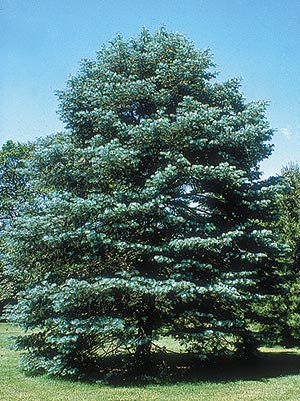
One of the finest firs, and perhaps larger conifers, for use in the Midwest and eastern areas of North America, this unusually showy specimen boasts 2- to 3-inch long, silvery blue foliage that is soft and aromatic. Although this majestic grower can reach 100 feet, it can be used in almost any full sun location that will accept its 20-foot spread. Known for its exceptional color and elegance, the white or concolor fir will be a winner when used as an alternative to the more commonly used forms of large evergreens. Although its silver blue color has earned concolor fir undeniable bragging rights, its large 3- to 6-inch cones often add to the show with their purplish bloom each summer.
The concolor fir is disease resistant under ordinary conditions. Due to its dense and full habit, no pruning should be necessary. Concolor fir is tolerant of almost any well-drained location, but would prefer a sandy or topsoil-filled area. These firs have done well in locations that are very arid with little or no topsoil to be found. When choosing a location, avoid heavy clay and low or wet spots. Consider a group of 3 or 5 concolor firs in the corner of a back or side yard to create a natural screen for privacy. This placement uses fewer plants than a traditional hedge or screen, while adding natural beauty and the element of depth to what could have been a rather boring spot in the yard. Since the white fir is extremely hardy, there is no need to shelter these beautiful specimens from the wind.
Concolor or white fir
Botanical name: Abies concolor (AY-beez KON-kull-er)
Plant type: Evergreen tree
Size: 40-60 feet tall, 20 feet wide (30 years); some may grow taller
Growth rate: Slow to medium
Leaf color: Silvery blue-green
Leaf size: 2- to 3-inch long needles
Light: Full sun for best results; will tolerate light shade
Soil: Prefers a well-drained site; will tolerate dry conditions once established
Hardiness: Zones 3-7
Landscape use: Best for open areas that drain well. Good alternative to spruces.
Special qualities: Develops 3- to 6-inch cones that mature to purple. Excellent disease and pest resistance. Superior form, color, and texture when compared to many other common large conifers.
Text and photo courtesy of the Michigan Nursery & Landscape Association.
